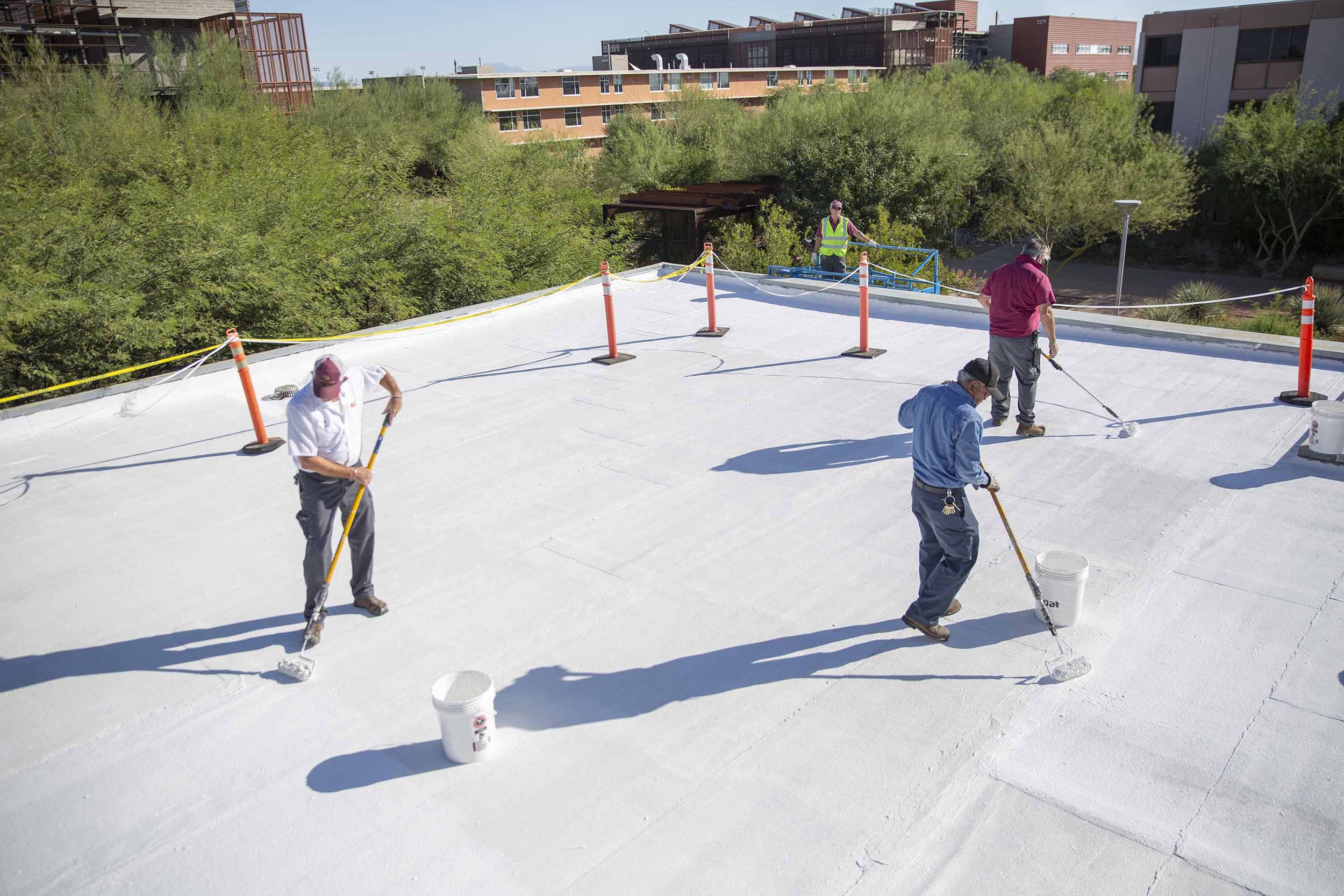EnKoat: ‘Making materials do amazing things’
Energy-efficient, environmentally-beneficial coatings
Convergence magazine > Making materials do amazing things
Aashay Arora and Matthew Aguayo’s new technique to make buildings more energy-efficient emerged from a very different project.
As engineering doctoral students, Arora and Aguayo worked with Fulton Schools professor Narayanan Neithalath to develop a concrete pavement that would be highly resistant to cracking under thermal stress. What they created was a pavement mixture that makes use of phase change materials, which can transform from solid to liquid and from liquid to solid and be used to store or release heat. They found the physical and chemical properties of the phase change materials kept the concrete significantly cooler, and thus much less likely to crack. Arora and Aguayo decided to explore whether adding phase change materials to paint, plaster and stucco — three of the most common coatings for buildings — could help maintain comfortable temperatures inside buildings.
Convergence magazine > Making materials do amazing things
Aashay Arora and Matthew Aguayo’s new technique to make buildings more energy efficient emerged from a very different project.
As engineering doctoral students, Arora and Aguayo worked with Fulton Schools professor Narayanan Neithalath to develop a concrete pavement that would be highly resistant to cracking under thermal stress. What they created was a pavement mixture that makes use of phase change materials, which can transform from solid to liquid and from liquid to solid and be used to store or release heat. They found the physical and chemical properties of the phase change materials kept the concrete significantly cooler, and thus much less likely to crack. Arora and Aguayo decided to explore whether adding phase change materials to paint, plaster and stucco — three of the most common coatings for buildings — could help maintain comfortable temperatures inside buildings.

Above: Arizona State University employees apply a coating to the roof of a classroom building at Arizona State University's Polytechnic campus to conduct a test of the new material's effectiveness. The coating developed by two recent graduates of ASU's civil, environmental and sustainable engineering doctoral program is designed to reduce the amount of energy needed maintain cool or warm temperatures inside buildings.
That project led to the startup EnKoat, Arora and Aguayo’s shorthand for their energy-saving coating. They and Neithalath see the material as a potential gamechanger in the energy efficiency technology industry.
The phase change materials do their work inside the coatings at a microscopic scale, while the surface texture of the coating on walls and roofs remains unchanged.
Beyond making EnKoat a successful business, Arora and Aguayo aspire to see their venture make a positive, widespread environmental impact.
By reducing the need for electrical power to run conventional heating and air conditioning units, EnKoat’s founders say if the company can go global, it would help keep millions of metric tons of harmful carbon emissions from entering the atmosphere every year.
Arora and Aguayo received their doctoral degrees in civil, environmental and sustainable engineering, with concentrations in structural and materials engineering at the end of the Fall 2018 semester.
Only a little more than a year later, the promising outlook for EnKoat landed the founders on Forbes magazine’s 30 Under 30 list as innovators who are “figuring out how to make new materials do amazing things.”
That project led to the startup EnKoat, Arora and Aguayo’s shorthand for their energy-saving coating. They and Neithalath see the material as a potential gamechanger in the energy efficiency technology industry.
The phase change materials do their work inside the coatings at a microscopic scale, while the surface texture of the coating on walls and roofs remains unchanged.
Beyond making EnKoat a successful business, Arora and Aguayo aspire to see their venture make a positive, widespread environmental impact.
By reducing the need for electrical power to run conventional heating and air conditioning units, EnKoat’s founders say if the company can go global, it would help keep millions of metric tons of harmful carbon emissions from entering the atmosphere every year.
Arora and Aguayo received their doctoral degrees in civil, environmental and sustainable engineering, with concentrations in structural and materials engineering at the end of the Fall 2018 semester.
Only a little more than a year later, the promising outlook for EnKoat landed the founders on Forbes magazine’s 30 Under 30 list as innovators who are “figuring out how to make new materials do amazing things.”